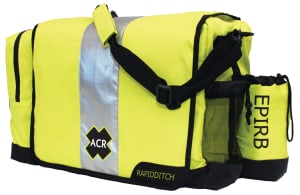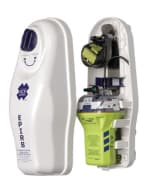What Should Be in Your Ditch Bag
 As boaters, it's our responsibility to do everything we can to remain safe on the water. However, no matter how much you prepare, unanticipated events can occur and it's important to be prepared for the worst – the need to abandon ship.
As boaters, it's our responsibility to do everything we can to remain safe on the water. However, no matter how much you prepare, unanticipated events can occur and it's important to be prepared for the worst – the need to abandon ship.
While the majority of boaters are usually within range of a quick rescue – especially if they have a properly operating 406 EPIRB or PLB on board – some boaters may be planning to travel to more remote areas where an abandon ship (ditch) bag will also be necessary. While no list can be considered complete, below we make some recommendations on items to include in your Abandon Ship Bag – from the most critical items, to the items that will make your wait for the rescuers more comfortable if you have the room (and time) to take them.
 Must Haves
Must Haves
First off are the absolute MUST HAVE items for your Abandon Ship Bag – all the items that will make the biggest difference in ensuring your successful rescue. These items should be in an enclosed waterproof container or bag, clearly labeled and located as close as possible to your life raft or where you exit your boat. Every person on board should know where this bag is and how to grab it in an emergency. As the captain, you should also ensure that the bag is not too heavy for any crew member to lift under highly adverse sea conditions – even if that means splitting it out into several bags. Here's what your bag should contain:
406 EPIRB or PLB – that has been registered and updated to include your current location and short term plans. This gives rescuers all of the important information about your boat, how many people are on board, and where you are supposed to be. You can update your information at any time at this website. Your 406 device be located where you can get it without re-entering your vessel as that may not be an option (such as in the event of a fire or a rapid sinking). The best option is often to mount it in a quick release bracket just inside the companionway or outside near your life raft. A 406 PLB is small enough to be stowed within your Abandon Ship Bag – so you may want to consider having both an EPIRB and a PLB.
- Waterproof Handheld VHF – imperative for being able to communicate with your rescuers. Make sure your VHF is fully charged and that you have backup batteries available (stored in a watertight baggie) if applicable to your unit. We recommend that you carry lithium and not alkaline batteries.
Waterproof Handheld GPS – being able to report your exact location will ensure your rescuers will find you much faster. Again – make sure your GPS unit is fully charged and have back-up batteries available if applicable. Again, we recommend lithium batteries.
- Flares – SOLAS grade, Aerial, Parachute and Handheld. Make sure to bring a complete variety that will show up well at any time – day or night. Most flares only last about 2 minutes and are a class D fire hazard – so handle them with care – especially when you are in your life raft.
- Flourescent Dye – use to mark the water for clearer visibility from above in daylight.
- Whistle – every person in the life raft should have a marine whistle attached to their life vest. The ability to make a lot of noise at a critical moment may help others find you in the water, or help get you rescued.
Signal Mirror – when you've used up your flares and your batteries are dead – this mirror may be your last hope.
- Strobe Lights – attach directly to your life jacket. These lights make you much easier to see and are required by the USCG and SOLAS requirements to operate for over 48 hours.
- Flashlight – a small, floating waterproof LED flashlight can prove extremely helpful on dark nights.
- Documents – this should include a passport for every person on board and any important ship's documents.
- Money – include some cash and several credit cards to help you get back to a safe place after you have been rescued.
Water – pack plastic water bottles – as many as you have room for. With a little air in the top they will float and they can be reused for collecting rainwater or water maker water if you have one.
- Food – since space will be at a premium, try to pack high energy, long storage foods such as power bars or survival biscuits. You need as many nutrients as possible in the smallest package.
- Sharp Knife – must have a case or fold back when not in use. Operate with care when on the raft.
- Prescription Medicines – extra vials of medications someone is taking should be packed into the bag. Don't count on being able to grab them out of the medicine cabinet in an emergency.
- Sunscreen – preferably +45 and waterproof.
Comfort Items
Okay – now that you've got the most important items in your Abandon Ship Bag – what other items should you bring? Following are items that are handy to have and will definitely make living in the raft more comfortable:
- Charts & Navigation Tools – it's good to know where you are – especially if you might be near a shipping lane – a good place to be when you need rescuing.
- Anti Seasickness Pills – if you have issues with seasickness, it's imperative that you bring these to avoid dehydration caused by vomiting.
First Aid Kit – to treat any injuries that come up.
- Spare Air Pump – keeps your raft fully inflated and more comfortable.
- Utility Tool – something like a Leatherman is just good to have around for a variety of uses.
- Fishing Kit – should include line, hooks, sinkers and some sort of attractor.
- Duct Tape – more uses than we can mention. Make sure to buy the type that is meant for outdoors and that can be used on wet surfaces.
Hand Operated Water Maker – make all the water you need – you'll have the time!
- Polypropylene Cord – use to secure items to the raft, string fish to dry or to hang clothes to dry.
- TPA – Thermal Protective Aid – like some sort of space blanket to keep you warm. These aid in keeping you dry and warm as the water under the raft will leach your warmth - even in the tropics.
- Garbage Bags & Ziplocks – great for keeping stuff organized and dry.
- Cushion – any type of cushion that will keep you out of the water, since wherever you sit will be the lowest point of the raft where water settles.
Light Sticks – use to read, attract fish or just provide general comfort at night.
- Full Coverage Clothing – for cold water, pack long underwear and a thermal hat – for warmer climates, pack long pants & a long sleeve shirt (preferably high-tech fabric) and a wide brim hat. Not only will these help protect you from the sun, they will wick moisture away from your skin and help with heat retention. Vacuum pack to take up less room.
- Sponge – helps keep the water on the outside of the raft. Store in a plastic bag when not using.
- Sea Soap – meant for use with salt water, use as needed.
- Toilet Paper – in a zip lock bag.
Sunglasses – to protect your eyes from the harsh glare of the sun on the water.
- Anti-Inflamatory/Analgesic – Ibuprofen or aspirin can make a huge difference in dealing with minor ailments.
- Antibiotic Cream – for all the small injuries that can become big without treatment.
- Vitamins – Use only if you have enough food and water in your system.
- Bandana – keeps your head from getting sunburned and can be used for a number of purposes.
Optional Items
Finally, here are some suggested items that would be great to have along if you have the room for them:
Note Pads/Pen/Pencil – good for navigation notes and keeping a log.
- Books/Playing Cards – you'll need some entertainment.
- Can Opener – in case you have time to offload canned goods.
- Floating Cutting Board – for use with your knife, tied to the raft. Can also be used as a paddle blade.
- Toothbrush/Dental Floss – for obvious reasons. Dental floss can also be used for many different purposes.
- Bug Repellent – critical if you make landfall.
Waterproof Fire Starter & Safety Matches – for use onshore even under the wettest conditions when starting a fire if you make landfall.
- Spear Gun – great if you make landfall, but not recommended for use on your raft unless you have extensive experience using it.
- Gaff Hook – see spear gun!
We hope you've found this list helpful if you are planning a remote excursion. At Fisheries Supply we are proud to employ many experts that can help you prepare for your next big trip – so please don't hesitate to contact our experts with any questions at (800) 426-6930.
Our special thanks to Safety Consultant Charlie Bond for his input on this Navigator.